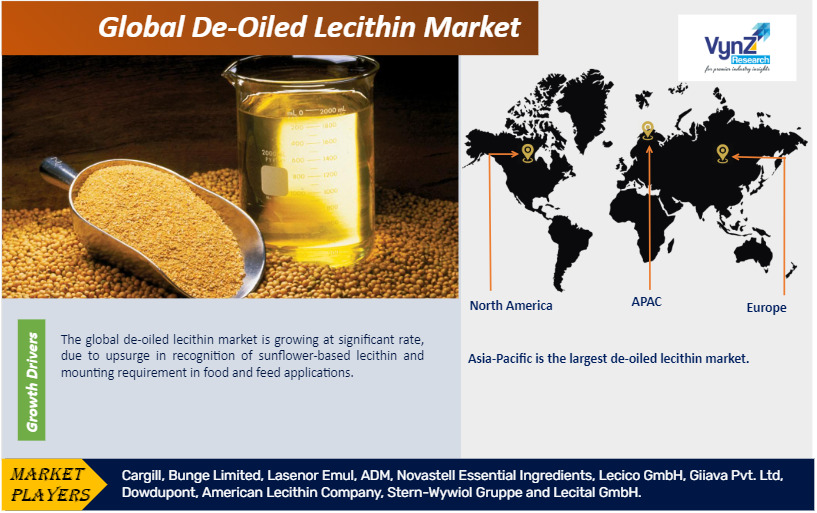Industry Overview
De-oiled lecithin is an ingredient that is majorly consumed as a releasing agent, antioxidant, wetting agent, stabilizer, instantizing agent, lubricant, and emulsifier. The global De-Oiled Lecithin Market is growing at a significant rate, due to an upsurge in recognition of sunflower-based lecithin and mounting requirements in food and feed applications.

The market has witnessed high demand for soy in the coming years due to adequate accessibility of soybean, mounting demand of natural sources in the cosmetic and pharmaceutical industry, and economical extraction procedures.
De-Oiled Lecithin Market Segmentation
Insight by Method of Extraction
Based on the method of extraction, the de-oiled lecithin market is subdivided into acetone extraction, ultrafiltration process, and carbon dioxide extraction. The ultrafiltration process is the most preferred method of extraction however; acetone extraction has few degrees of toxicity as residual after desolventizing.
Insight by Source
Based on source, the market is subdivided into soy, rapeseed, egg, and sunflower. Adequate accessibility of soybeans, mounting demand for natural sources in the cosmetic and pharmaceutical industry, upsurge in animal feed applications owing to low cost and economical extraction procedure are some of the factors responsible for the growth of the soy segment. Of all the sources, the soy segment accounted foremost share in the de-oiled lecithin market. However, an alteration in the need for soy to supplementary supplies such as rapeseed and sunflower, due to genetically modified organisms (GMO) affairs related to soy lecithin has been observed in the market.
Insight by Application
Based on application, the market is subdivided into food, healthcare, and feed. Among the all applications, the food application accounted for the largest share in the de-oiled lecithin market due to an upsurge in health-conscious customers, escalating demand for sugar confectionery, convenient foods, and chocolates in Asian countries, and mounting alertness of advantages of nutritious food intake. In addition, the healthcare application is expected to grow at the fastest rate in the market due to the intensifying need for herbal and natural nutritional products in pharmaceuticals and mounting healthcare expenditure.
The food segment is further subdivided into convenience foods, bakery products, dairy & frozen desserts, confectionery products, and others. The confectionery products accounted for the largest share of the market due to an increase in demand high quality chocolates. For instance, de-oiled lecithin is an essential ingredient in chocolate processing. It offers viscosity control, upsurges the processing stability, and decreases the processing duration during the production of chocolate. In addition, the upsurge in the cost of cocoa butter has compelled manufacturers to shift their interest to de-oiled lecithin as it is the cost-effective and suitable alternative.
Global De-Oiled Lecithin Market Report Coverage
|
Report Metric
|
Details
|
|
Historical Period
|
2018 - 2023
|
|
Base Year Considered
|
2024
|
|
Forecast Period
|
2025 - 2030
|
|
Market Size in 2024
|
U.S.D. XX Billion
|
|
Revenue Forecast in 2030
|
U.S.D. XX Billion
|
|
Growth Rate
|
XX%
|
|
Segments Covered in the Report
|
By Method of Extraction, By Source and By Application
|
|
Report Scope
|
Market Trends, Drivers, and Restraints; Revenue Estimation and Forecast; Segmentation Analysis; Impact of COVID-19; Companies’ Strategic Developments; Market Share Analysis of Key Players; Company Profiling
|
|
Regions Covered in the Report
|
North America, Europe, Asia-Pacific, Middle East, and Rest of the World
|
Industry Dynamics
Progression in trend for natural food additives, upsurge in recognition of sunflower-based lecithin, mounting consumer alertness regarding clean label products, and upsurge in requirement for convenience food are the primary growth drivers for the de-oiled lecithin market. Shifting user lifestyles, mounting necessity for trans-fatty acid and healthy snacking, and mounting requirements in food and feed applications are also facilitating the growth of the de-oiled lecithin market.
Imitation of de-oiled lecithin by artificial substitutes, variation in raw material rates, apprehensions about GMOs, and allergens issues related to soy are the major challenges for the growth of the de-oiled lecithin market.
Globally, the manufacturing companies trying to enter the de-oiled lecithin market are required to maintain stringent regulatory standards. This offers an edge to the established players in the industry competition.
De-Oiled Lecithin Market Geographic Overview
Geographically, Asia-Pacific is the largest de-oiled lecithin market as in the region the export opportunities of non-GMO lecithin are increasing, and consumers are becoming aware of the advantages of healthy food and feed.
The growing aquaculture industry in China, escalating demand for sugar confectionery, convenient foods, and chocolates, upsurge in meat intake, obtainability of resources such as soy, escalation in requirement for non-allergic and organic food, growth of the aquaculture industry, and high investment growth in the pharma and personal care industry have the growth of the de-oiled lecithin industry in the Asia Pacific.
Furthermore, the growing adoption of a premium lifestyle with quality food, mounting healthcare expenditure an increase in animal husbandry, and augmented requirement for personal care products and cosmetics are also surging growth of the Asia-Pacific de-oiled lecithin market.
De-Oiled Lecithin Market Competitive Insight
Key players in the de-oiled lecithin market are catering to the demand by investing in new product launches in their product portfolios across the globe. Cargill introduced de-oiled lecithin products to complete its GMO and non-GMO lecithin product portfolio.
Cargill, Incorporated, is an American global food corporation based in Minnetonka, Minnesota, and incorporated in Wilmington, Delaware.
Stern-Wywiol Gruppe and Lecital GmbH innovation meets experience, ingredients meet technologies. Company's expertise and passion is the food. They supply humanity with safe, affordable and good-tasting food, and partner with food manufacturers all over the world to develop functional systems for food additives.
Cargill, Bunge Limited, Lasenor Emul, ADM, Novastell Essential Ingredients, Lecico GmbH, Giiava Pvt. Ltd, Dowdupont, American Lecithin Company, Stern-Wywiol Gruppe and Lecital GmbH are the key players operating in the market.
Recent Developments by Key Players
Stern-Wywiol Gruppe and Lecital GmbH opened the new Stern Ingredients China building in Suzhou. Company can develop individual product solutions to meet customer needs quickly and precisely.
Chevron U.S.A. Inc. (a subsidiary of Chevron Corporation) Bunge North America, Inc., a subsidiary of Bunge Limited collaborated to create renewable feedstocks leveraging Bunge's expertise in oilseed processing and farmer relationships and Chevron's expertise in fuels manufacturing and marketing.



